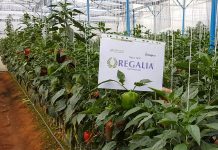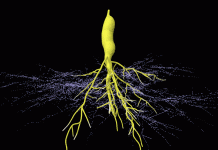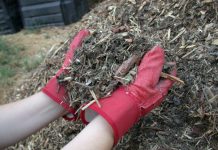By Dr. Rebecca White, Vice President of Operations, iWi (Qualitas Health, Inc.) for Biofuels Digest

This Wednesday marks a major milestone in the history of the American algae industry: the first meeting in which the Biomass R&D Board Technical Advisory Committee officials will discuss algae as an agricultural crop. Up until now, the vast majority of governmental funding and support has gone to one particular application of algae: biofuels. The success of biofuels is extremely important. But so is the success of algae in other applications, such as protein, omega-3s and fish and animal feed, which all have the potential to change the way we feed and nourish the world.
As an 11-year veteran of the algae industry, I’ve dedicated my entire career to proving the principle that algae is agriculture, first at Sapphire Energy, focused on translating traditional agronomic practices to algae, and recently as an industry professional growing algae at commercial scale. In my current role as VP of Operations for the food and nutrition company iWi, my team and I grow algae in open ponds on large scale farms throughout the Southwest United States, using the tools of crop protection and agronomic practices utilized by traditional farmers throughout the nation. Through all this work, I’ve learned a simple lesson: if you want to grow algae as a crop, you have to treat it like one. This mindset is what is critical to reaching scale and is the secret to iWi’s success.
Today’s meeting signals a new beginning for algae, which is finally on the cusp of being categorized as a mainstream crop, a designation that could drive algae’s fortunes in the decades to come. This significant but quiet transition – a momentous occasion for the industry – deserves some recognition, and a few comments on where it can take us.
The Department of Energy has brought algae this far – now the USDA can help take it further
It’s no exaggeration to say that the broader algae industry owes much of its progress – both technologically and commercially – to the DOE’s dedicated stewardship. For the 50 years preceding the 2018 Farm Bill, most of the investment into algae research was done by the Department of Energy, so it was no accident that the vast majority of grants and support were directed towards algal biofuels. This investment in biofuels also benefited the entire industry by leading to technology advancements that have opened up the possibilities for algae-based products of all sorts. In addition to the traditional nutraceuticals, supplements and cosmetic ingredients that have been the quiet, steady foundation of the commercial side of the industry, we are now seeing major, successful commercial endeavors in aquaculture feed, animal feed, human food and ingredients, materials, wastewater cleanup and other related areas.
The 2018 Farm Bill was a critical turning point for algae’s crop status
With this foundation in mind, we stand at a crossroads for the future of algae. The algae industry will likely be discussed in two distinct forms: before and after the Farm Bill of 2018. As part of the 2018’s Farm Bill reclassification of algae as a crop, the USDA – a department concerned with food, agriculture and nutrition – will contribute its unique federal role to help the algae industry achieve a new scale of work. By widening the government’s focus from biofuels to supporting an entire crop ecosystem (algae biomass), the Farm Bill paved the way for algae to be regulated and supported alongside other crops like wheat, corn and soy; the USDA will be building an algae production assistance and research program complementary to the currently ongoing research under DOE and other programs. Put simply, this means that the federal priority has expanded from supporting algal biofuels to algae biomass of all sorts – agnostic of products.
In order to get there, we’re going to need USDA and the DOE work closely together
The USDA can further expand the foundation that DOE created with its commitment to supporting algae technology and commercial development. DOE’s continued role in the space will help ensure that near term innovations in the algae industry are enabling of a long-term future, which includes biofuels.
As a start, here are three concrete recommendations that the Algae Industry Working Group can use to get its 2019 works started on the right foot:
- Build on the DOE’s 5+ decades of work: The DOE has compiled many years of algae research and production data from their programs. This data could benefit the development of USDA programs such as the Biomass Crop Assistance Program, Crop Insurance, and the Algae Agriculture Research Program. Additionally, it could be used to develop a primer on algae production for the USDA Extension Service, to better serve algae producers, especially in states with large production facilities.
- Establish a handful of “reference” algal species: Reference varieties are used for trials of other crops like wheat and soy; one of the issues with algal research is a lack of standard reference strains. Identifying a series of reference algal species and sequencing their genomes to support future R&D efforts would help the industry better standardize field trials (at a minimum).
- Be inclusive of CO2 capture and delivery technologies: Many of the current CO2 capture and re-use scenarios for algae facilities are centered around co-localization with emitters, and are focused on future facilities. We need to ensure that Direct Air Capture technology for CO2 delivery is supported in the regulations so algae facilities can more easily participate in the CO2 economy; it removes the co-localization requirement and makes room for current algae facilities that are not co-located with emitters to participate.
We now sit at the beginning of a new chapter for the algae industry. We have the opportunity to elevate algae from a niche research project to a mainstream crop, and it’s ours for the taking. I’m looking forward to working with the rest of the industry and our partners in government agencies to make this happen.
This article was first published on Biofuels Digest. Biofuels Digest is the most widely read Biofuels daily read by 14,000+ organizations. Subscribe here.








